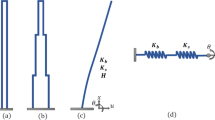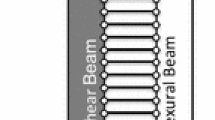Abstract
In this paper, an equivalent one-dimensional beam model immersed in a three-dimensional space is proposed to study the aeroelastic behavior of tower buildings: linear and nonlinear dynamics are analyzed through a simple but realistic physical modeling of the structure and of the load. The beam is internally constrained, so that it is capable to experience shear strains and torsion only. The elasto-geometric and inertial characteristics of the beam are identified from a discrete model of three-dimensional frame, via a homogenization process. The model accounts for the torsional effect induced by the rotation of the floors around the tower axis; the macroscopic shear strain is produced by bending of the columns, accompanied by negligible rotation of the floors. Nonlinear aerodynamic forces are evaluated through the quasi-steady theory. The first aim is to investigate the effect of mechanical and aerodynamic coupling on the critical galloping conditions. Furthermore, the role of aerodynamic nonlinearities on the galloping post-critical behavior is analyzed through a perturbation solution which permits to obtain a reduced one-dimensional dynamical system, capable of capturing the essential dynamics of the problem.
Similar content being viewed by others
References
Greco L., Cuomo M.: An implicit G1 multi patch B-spline interpolation for Kirchhoff–Love space rod. Comput. Methods Appl. Mech. Eng. 269, 173–197 (2014)
Cazzani, A., Malagù, M., Turco, E.: Isogeometric analysis of plane-curved beams. Math. Mech. Solids (2014). doi:10.1177/1081286514531265
Balendra T., Swaddiwudhipong S., Quek S.-T., Lee S.-L.: Approximate analysis of asymmetric buildings. J. Struct. Eng. 110(9), 2056–2072 (1984)
Carpinteri A., Lacidogna G., Puzzi S.: A global approach for three dimensional analysis of tall buildings. Struct. Des. Tall Spec. Build. 19, 518–536 (2010)
Basu A.K., Dar G.Q.: Dynamic characteristics of coupled wall-frame systems. Earthq. Eng. Struct. Dyn. 10, 615–631 (1982)
Miranda E., Taghavi S.: Approximate floor acceleration demands in multistory buildings. I: formulation. J. Struct. Eng. ASCE 131, 203–211 (2005)
Malekinejad M., Rahgozar R.: A simple analytic method for computing the natural frequencies and mode shapes of tall buildings. Appl. Math. Model. 36, 3419–3432 (2012)
Malekinejad M., Rahgozar R.: An analytical model for dynamic response analysis of tubular tall buildings. Struct. Des. Tall Spec. Build. 23(1), 67–80 (2014)
Dym C.L., Williams H.E.: Estimating fundamental frequencies of tall buildings. J. Struct. Eng. ASCE 133(10), 1479–1483 (2007)
Dym C.L.: Approximating frequencies of tall buildings. J. Struct. Eng. ASCE 139(2), 288–293 (2013)
Patrickson C.P., Friedmann P.P.: Deterministic torsional building response to wind. J. Struct. Div. 105(ST12), 2621–2637 (1979)
Torkamani M.A.M., Pramono E.: Dynamic response of tall building to wind excitation. J. Struct. Eng. ASCE 111(4), 805–825 (1985)
Balendra T., Nathan G.K., Kang K.H.: Deterministic model for wind-induced oscillations of buildings. J. Eng. Mech. ASCE 115(1), 179–199 (1989)
Cluni F., Gioffrè M., Gusella V.: Dynamic response of tall buildings to wind loads by reduced order equivalent shear-beam models. J. Wind Eng. Ind. Aerodyn. 123, 339–348 (2013)
Chajes M.J., Romstad K.M., McCallen D.B.: Analysis of multiple-bay frames using continuum model. J. Struct. Eng. ASCE 119(2), 522–546 (1993)
Luongo A., Zulli D.: Mathematical Models of Beams and Cables. Wiley-ISTE, London (2013)
Shuguo L., Qiusheng L., Guiqing L., Weilian Q.: An evaluation of onset wind velocity for 2-D coupled galloping oscillations of tower buildings. J. Wind Eng. Ind. Aerodyn. 50, 329–340 (1993)
Luongo A., Zulli D.: Parametric, external and self-excitation of a tower under turbulent wind flow. J. Sound Vib. 330, 3057–3069 (2011)
Madeo A., Djeran-Maigre I., Rosi G., Silvani C.: The effect of fluid streams in porous media on acoustic compression wave propagation, transmission, and reflection. Contin. Mech. Thermodyn. 25(2–4), 173–196 (2013)
Luongo A., Piccardo G.: Linear instability mechanisms for coupled translational galloping. J. Sound Vib. 288, 1027–1047 (2005)
Païdoussis M.P., Price S.J., de Langre E.: Fluid–Structure Interactions—Cross-Flow-Induced Instabilities. Cambridge University Press, New York (2011)
dell’Isola F., Rosa L., Woźniak C.: Dynamics of solids with micro periodic nonconnected fluid inclusions. Arch. Appl. Mech. 67, 215–228 (1997)
dell’Isola F., Rosa L., Woźniak C.: A micro-structured continuum modelling compacting fluid-saturated grounds: the effects of pore-size scale parameter. Acta Mech. 127(1–4), 165–182 (1998)
Steigmann D., Faulkner G.M.: Variational theory for spatial rods. J. Elast. 33(1), 1–26 (1993)
Alibert J., Seppecher P., dell’Isola F.: Truss modular beams with deformation energy depending on higher displacement gradients. Math. Mech. Solids 8(1), 51–73 (2003)
dell’Isola F., Seppecher P., Madeo A.: How contact interactions may depend on the shape of Cauchy cuts in N th gradient continua: approach “à la D’Alembert”. Z. Angew. Math. Phys. ZAMP 63(6), 1119–1141 (2012)
dell’Isola, F., Andreaus, U., Placidi, L.: At the origins and in the vanguard of peridynamics, non-local and higher gradient continuum mechanics. An underestimated and still topical contribution of Gabrio Piola. Math. Mech. Solids (MMS), first published on February 2, 2014 as doi:10.1177/1081286513509811 (2014)
Bîrsan M., Altenbach H., Sadowski T., Eremeyev V.A., Pietras D.: Deformation analysis of functionally graded beams by the direct approach. Compos. Part B Eng. 43(3), 1315–1328 (2012)
Piccardo, G., Pagnini, L.C., Tubino, F.: Some research perspectives in galloping phenomena: critical conditions and postcritical behavior. Contin. Mech. Thermodyn. doi:10.1007/s00161-014-0374-5 (2014)
Luongo A., Zulli D., Piccardo G.: On the effect of twist angle on nonlinear galloping of suspended cables. Comput. Struct. 87, 1003–1014 (2009)
Nayfeh A.H., Mook D.T.: Nonlinear Oscillations. Wiley, New York (1979)
Nakamura Y., Mizota T.: Torsional flutter of rectangular prisms. J. Eng. Mech. Div. ASCE 101(EM2), 125–142 (1975)
Tamura T., Miyagi T.: The effect of turbulence on aerodynamic forces on a square cylinder with various corner shapes. J. Wind Eng. Ind. Aerodyn. 83, 135–145 (1999)
Li Q.S., Fang J.P., Jeary A.P.: Evaluation of 2D coupled galloping oscillations of slender structures. Comput. Struct. 66(5), 513–523 (1998)
Pagnini L.C.: Model reliability and propagation of frequency and damping uncertainties in the dynamic along-wind response of structures. J. Wind Eng. Ind. Aerodyn. 59(2–3), 211–231 (1996)
Pagnini L.: Reliability analysis of wind-excited structures. J. Wind Eng. Ind. Aerodyn. 98(1), 1–9 (2010)
Roveri N., Carcaterra A., Akay A.: Energy equipartition and frequency distribution in complex attachments. J. Acoust. Soc. Am. 126(1), 122–128 (2009)
Luongo A., Piccardo G.: A continuous approach to the aeroelastic stability of suspended cables in 1:2 internal resonance. J. Vib. Control 14(2), 135–157 (2008)
dell’Isola F., Rosa L.: Perturbation methods in torsion of thin hollow Saint-Venant cylinders. Mech. Res. Commun. 23(2), 145–150 (1996)
dell’Isola F., Ruta G.: Perturbation series for shear stress in flexure of Saint-Venant cylinders with Bredt-like sections. Mech. Res. Commun. 23(5), 557–564 (1996)
Piccardo G., Carassale L., Freda A.: Critical conditions of galloping for inclined square cylinders. J. Wind Eng. Ind. Aerodyn. 99(6–7), 748–756 (2011)
Author information
Authors and Affiliations
Corresponding author
Rights and permissions
About this article
Cite this article
Piccardo, G., Tubino, F. & Luongo, A. A shear–shear torsional beam model for nonlinear aeroelastic analysis of tower buildings. Z. Angew. Math. Phys. 66, 1895–1913 (2015). https://doi.org/10.1007/s00033-014-0456-z
Received:
Revised:
Published:
Issue Date:
DOI: https://doi.org/10.1007/s00033-014-0456-z




